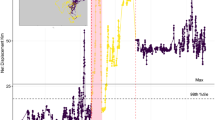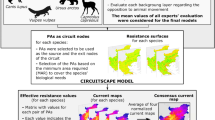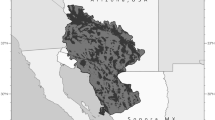Abstract
Context
Habitat loss and fragmentation are among the major drivers of population declines and extinction, particularly in large carnivores. Connectivity models provide practical tools for assessing fragmentation effects and developing mitigation or conservation responses. To be useful to conservation practitioners, connectivity models need to incorporate multiple scales and include realistic scenarios based on potential changes to habitat and anthropogenic pressures. This will help to prioritize conservation efforts in a changing landscape.
Objectives
The goal of our paper was to evaluate differences in population connectivity for lions (Panthera leo) across the Kavango-Zambezi Trans-frontier Conservation Area (KAZA) under different landscape change scenarios and a range of dispersal distances.
Methods
We used an empirically optimized resistance surface, based on analysis of movement pathways of dispersing lions in southern Africa to calculate resistant kernel connectivity. We assessed changes in connectivity across nine landscape change scenarios, under each of which we explored the behavior of lions with eight different dispersal abilities.
Results
Our results demonstrate that reductions in the extent of the protected area network and/or fencing protected areas will result in large declines in the extent of population connectivity, across all modeled dispersal abilities. Creation of corridors or erection of fences strategically placed to funnel dispersers between protected areas increased overall connectivity of the population.
Conclusions
Our results strongly suggest that the most effective means of maintaining long-term population connectivity of lions in the KAZA region involves retaining the current protected area network, augmented with protected corridors or strategic fencing to direct dispersing individuals towards suitable habitat and away from potential conflict areas.






Similar content being viewed by others
References
Bauer H, Nowell K, Packer C (2012) Panthera leo. IUCN Red List of Threatened Species. www.iucnredlist.org. Accessed 26 July 2013
Beier P, Majka DR, Spencer WD (2008) Forks in the road: choices in procedures for designing wildland linkages. Conserv Biol 22:836–851
Bjorklund M (2003) The risk of inbreeding due to habitat loss in the lion (Panthera leo). Conserv Genet 4:515–523
Carr LW, Fahrig L (2001) Effect of road traffic on two amphibian species of differing vagility. Conserv Biol 15:1071–1078
Compton BW, McGarigal K, Cushman SA, Gamble LR (2007) A resistant-kernel model of connectivity for amphibians that breed in vernal pools. Conserv Biol 21(3):788–799
Creel S, Becker MS, Durant SM, M'Soka J, Matandiko W, Dickman AJ, Christianson D, Dröge E, Mweetwa T, Pettorelli N, Rosenblatt E, Schuette P, Woodroffe R, Bashir S, Beudels-Jamar RC, Blake S, Borner M, Breitenmoser C, Broekhuis F, Cozzi G, Davenport TRB, Deutsch J, Dollar L, Dolrenry S, Douglas-Hamilton I, Fitzherbert E, Foley C, Hazzah L, Henschel P, Hilborn R, Hopcraft JGC, Ikanda D, Jacobson A, Joubert B, Joubert D, Kelly MS, Lichtenfeld L, Mace GM, Milanzi J, Mitchell N, Msuha M, Muir R, Nyahongo J, Pimm S, Purchase G, Schenck C, Sillero-Zubiri C, Sinclair ARE, Songorwa AN, Stanley-Price M, Tehou CA, Trout C, Wall J, Wittemyer G, Zimmermann A (2013) Conservin large populations of lions—the argument for fences has holes. Ecol Lett. doi:10.1111/elel.12145
Cushman SA (2006) Effects of habitat loss and fragmentation on amphibians: a review and prospectus. Biol Conserv 128(2):231–240
Cushman SA, Landguth EL (2012) Multi-taxa population connectivity in the northern Rocky Mountains. Ecol Model 231:101–112
Cushman SA, Lewis JS (2010) Movement behavior explains genetic differentiation in American black bear. Landscape Ecol 25:1613–1625
Cushman SA, Chase M, Griffin C (2010a) Mapping landscape resistance to identify corridors and barriers to elephant movement in southern Africa. In: Cushman SA, Huettman F (eds) Spatial complexity, informatics and wildlife conservation. Springer, Tokyo, pp 349–367
Cushman SA, Compton BA, McGarigal K (2010b) Habitat fragmentation effects depend on complex interactions between population size and dispersal ability: Modeling influences of roads, agriculture and residential development across a range of life-history characteristics. In: Cushman SA, Huettman F (eds) Spatial complexity, informatics and wildlife conservation. Springer, Tokyo, pp 369–385
Cushman SA, Landguth EL, Flather CH (2012) Evaluating the sufficency of proteted lands for maintaining wildlife population connectivity in the US northern Rocky Mountains. Divers Distrib 18:873–884
Cushman SA, McRae B, Adriaensen F, Beier P, Shirley M, Zeller K (2013) Biological corridors and connectivity. In: Macdonald DW, Willis KJ (eds) Key topics in conservation biology 2. Wiley, Oxford, pp 384–404
Cushman SA, Lewis JS, Landguth EL (2014) Why did the bear cross the Road? Comparing he performance of multiple resistance surfaces and connectivity modeling approaches. Diversity 6:844–854
Elliot NB, Cushman SA, Loveridge AJ, Mtare G, Macdonald DW (2014a) Movements vary according to dispersal stage, group size, and rainfall: the case of the African lion. Ecology 95(10):2860–2869
Elliot NB, Cushman SA, Macdonald DW, Loveridge AJ (2014b) The devil is in the dispersers: predictions of landscape connectivity change with demography. J Appl Ecol 51(5):1169–1178
Elliot NB, Valeix M, Macdonald DW, Loveridge AJ (2014c) Social relationships affect dispersal timing revealing a delayed infanticide in African lions. Oikos 123(9):1049–1056
Gibbs JP (1998) Amphibian movements in response to forest edges, roads and streambeds in southern New England. J Wildl Manag 62:584–589
IUCN-SSC (2006) Conservation strategy for the lion Panthera leo in eastern and southern Africa. IUCN SSC Cat Specialist Group. www.felidae.org
Kramer-Schadt S, Revilla E, Wiegand T, Breitenmoser U (2004) Fragmented landscapes, road mortality and patch occupancy: modelling influences on the dispersal of the Eurasian lynx. J Appl Ecol 41:711–723
Landguth EL, Cushman SA (2010) CDPOP: A spatially explicit cost distance population genetics program. Mol Ecol Resour 10:156–161
Landguth EL, Hand BK, Glassy J, Cushman SA, Sawaya MA (2012) UNICOR: a species connectivity and corridor network simulator. Ecography 35(1):9–14
Lindsey PA, Alexander R, Frank LG, Mathieson A, Romañach SS (2006) Potential of trophy hunting to create incentives for wildlife conservation in Africa where alternative wildlife-based land uses may not be viable. Anim Conserv 9:283–291
Lindsey PA, Balme GA, Booth VR, Midlane N (2012) The significance of African lions for the financial viability of trophy hunting and the maintenance of wild land. PLoS One 7:e29332. doi:10.1371/journal.pone.0029332
Loveridge AJ, Canney S (2009) Report on the lion distribution and conservation modelling project. Report to the Born Free Foundation, UK
Loveridge AJ, Searle AW, Muridagomo F, Macdonald DW (2007) The impact of sport-hunting on the population dynamics of an African lion population in a protected area. Biol Conserv 134:548–558
Loveridge AJ, Hemson G, Davidson Z, Macdonald DW (2010) African lions on the edge: reserve boundaries as ‘attractive sinks’. In: Macdonald DW, Loveridge AJ (eds) The biology and conservation of wild felids. Oxford University Press, Oxford, pp 283–304
McGarigal K, Cushman SA, Ene E (2012) FRAGSTATS v4: spatial pattern analysis program for categorical and continuous maps. Computer software program produced by the authors at the University of Massachusetts, Amherst. http://www.umass.edu/landeco/research/fragstats/fragstats.html
Miller SD, Funston PJ (2014) Rapid growth rates of lion (Panthera leo) populations in small fenced reserves in South Africa: a management dilemma. S Afr J Wildl Res 44:43–55
Newcomb Homan R, Windmiller BS, Reed JM (2004) Critical thresholds associated with habitat loss for two vernal pool-breeding amphibians. Ecol Appl 14:1547–1553
Packer C, Pusey AE, Rowley H, Gilbert DA, Martenson J, O’Brien SJ (1991) Case study of a population bottleneck: lions of the Ngorongoro Crater. Conserv Biol 5(2):219–230
Packer C, Loveridge A, Canney S, Caro T, Garnett ST, Pfeifer M, Zander KK, Swanson A, MacNulty D, Balme G, Bauer H, Begg CM, Begg KS, Bhalla S, Bissett C, Bodasing T, Brink H, Burger A, Burton AC, Clegg B, Dell S, Delsink A, Dickerson T, Dloniak SM, Druce D, Frank L, Funston P, Gichohi N, Groom R, Hanekom C, Heath B, Hunter L, DeIongh HH, Joubert CJ, Kasiki SM, Kissui B, Knocker W, Leathem B, Lindsey PA, Maclennan SD, McNutt JW, Miller SM, Naylor S, Nel P, Ng'weno C, Nicholls K, Ogutu JO, Okot-Omoya E, Patterson BD, Plumptre A, Salerno J, Skinner K, Slotow R, Sogbohossou EA, Stratford KJ, Winterbach C, Winterbach H, Polasky S (2013a) Conserving large carnivores: dollars and fence. Ecol Lett 16(5):635–641
Packer C, Swanson A, Canney S, Loveridge A, Garnett S, Pfeifer M, Burton AC, Bauer H, MacNulty D (2013b) The case for fencing remains intact. Ecol Lett 16(11):1414
Pfeifer M, Packer C, Burton AC, Garnett ST, Loveridge AJ, MacNulty D, Platts PJ (2014) In defense of fences. Science 345(6195):389
Population Reference Bureau (2013) 2013 world population data sheet. http://www.prb.org/pdf13/2013-population-data-sheet_eng.pdf
PPF (2013) Peace parks foundation. http://www.peaceparks.org. Accessed 20 July 2013
Riggio J, Jacobson A, Dollar L, Bauer H, Becker M, Dickman A, Funston P, Groom R, Henschel P, Iongh H, Lichtenfeld L, Pimm S (2013) The size of savannah Africa: a lion’s (Panthera leo) view. Biodivers Conserv 22(1):17–35
Rudnick D, Ryan S, Beier P, Cushman S, Dieffenbach F, Epps C, Gerber L, Hartter J, Jenness J, Kintsch J, Merenlender A, Perkl R, Preziosi D, Trombulak S (2012) The role of landscape connectivity in planning and implementing conservation and restoration priorities. Issues Ecol 16:1–20
Sawyer SC, Epps CW, Brashares JS (2011) Placing linkages among fragmented habitats: do least-cost models reflect how animals use landscapes? J Appl Ecol 48(3):668–678
Schwartz MK, Mills LS (2005) Gene flow after inbreeding leads to higher survival in deer mice. Biol Conserv 123:413–420
Trinkel M, Cooper D, Packer C, Slotow R (2011) Inbreeding depression increases susceptibility to bovine tuberculosis in lions: an experimental test using an inbred–outbred contrast through translocation. J Wildl Dis 47(3):494–500
Winterbach HEK, Winterbach CW, Somers MJ, Hayward MW (2013) Key factors and related principles in the conservation of large African carnivores. Mamm Rev 43(2):89–110
Woodroffe R, Frank L (2005) Lethal control of African lions (Panthera leo): local and regional population impacts. Anim Conserv 8:91–98
Woodroffe R, Hedges S, Durant SM (2014) To fence or not to fence. Science 344(6179):46–48
Zeller KA, McGarigal K, Whiteley AR (2012) Estimating landscape resistance to movement: a review. Landscape Ecol 27(6):777–797
Author information
Authors and Affiliations
Corresponding author
Additional information
Special issue: Multi-scale habitat modeling.
Guest Editor: K. McGargial and S. A. Cushman.
Electronic supplementary material
Below is the link to the electronic supplementary material.
Rights and permissions
About this article
Cite this article
Cushman, S.A., Elliot, N.B., Macdonald, D.W. et al. A multi-scale assessment of population connectivity in African lions (Panthera leo) in response to landscape change. Landscape Ecol 31, 1337–1353 (2016). https://doi.org/10.1007/s10980-015-0292-3
Received:
Accepted:
Published:
Issue Date:
DOI: https://doi.org/10.1007/s10980-015-0292-3




